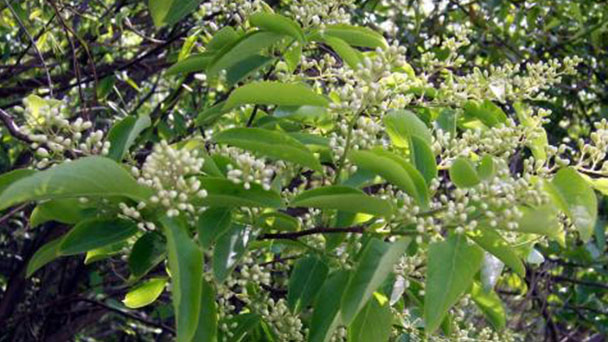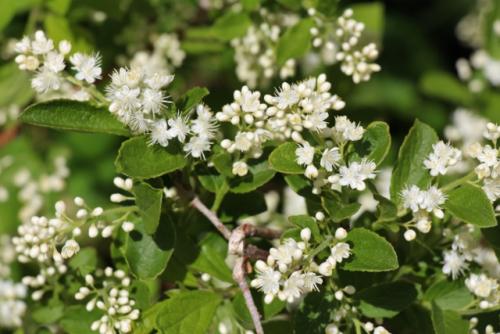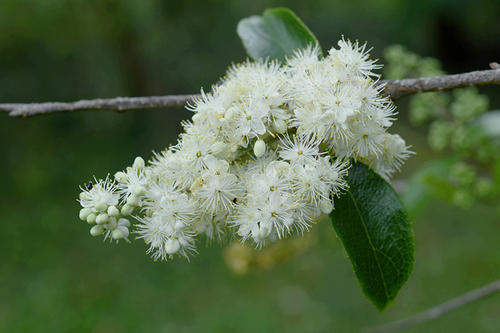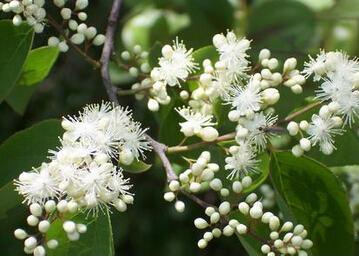Symplocos paniculata profile
Written by Maggie
Mar 09 2021

Symplocos paniculata (Thunb.) Miq., also known as Asiatic sweetleaf or sapphire-berry, is a deciduous shrub or small tree of the genus Pachyderma in the family Pachyderma. Symplocos paniculata is up to 5 meters high and its young branches are hairy. Leaves are alternate, elliptic, 4-9.5 cm long and 2-5.5 cm wide, margin finely serrated. Panicle branch is apex, white flowers. Drupe is ovate, black. Symplocos paniculata can be used as a device or medicine.
Symplocos paniculata is widely distributed in northeastern China and the areas south of the Yellow River, especially in the provinces south of the Yangtze River basin. More than 200-1000m in the hills of Haidial sparse forest, shrubs and Quaternary red soil light slope. symplocos paniculata is one of the excellent soil and water conservation tree species with good growth in sunny slope and gully area, early barren tolerance, developed root system, strong germination ability and easy propagation.
Symplocos paniculata picture

Symplocos paniculata info
| Botanical Name | Symplocos paniculata |
| Common Names | Asiatic sweetleaf or sapphire-berry |
| Plant Type | Deciduous shrub |
| Light | Full sun |
| Native Areas | Himilayas, eastern Asia |
| USDA hardiness | 4 to 8 |
| Flower | Showy, Fragrant |
| Mature size | 10.00 to 20.00 feet high, 10.00 to 25.00 feet wide |
Morphological characteristics of Symplocos paniculata
Branch
Symplocos paniculata is a deciduous shrub or small tree; Young branches are gray-white pilose, older branches glabrous.
Leaf
Leaves of Symplocos paniculata are membranous or thin-papered, broadly obovate, elliptically obovate or ovate, 3-11 cm long and 2-4 cm wide, acute or acuminate at the apex, broadly cuneate or suborbicular at the base, margin serrate, glabrous or pilose, often pilose at the back or only on veins; Mid Veins concave under leaves, lateral veins flat or slightly raised, 4-8 on each side; Petiole of Symplocos paniculata is 3-5 mm long.
Flowers
Symplocos paniculata is a panicle 5 -- 8 cm long, usually pubescent; Bracts are caducous, usually striate, with brown glandular spots; Calyx is 2 -- 3 mm long, calyx tube brown, glabrous or pubescent, lobes semicircular or ovate, slightly longer than calyx tube, pale yellow, longitudinally veinous, margin hairy; Corolla is white, 4-5 mm long, 5-lobed few to base; Symplocos paniculata has 40-60 stamens, ovary 2-loculed, disk with 5 raised glandular spots.
Fruit
Drupes of Symplocos paniculata are blue when ripe, ovoid globose, slightly oblique, 5 -- 8 mm long, apex calyx lobes erect.
Ecological habits of Symplocos paniculata
Symplocos Paniculata is born on hillsides, along roadsides, in open or dense forests at an altitude of 760-2500m.
Symplocos Paniculata prefers warm and humid climates and deep, fertile sandy loam. It is light tolerant and slightly shade tolerant. Deep - rooted tree species, strong adaptability, cold resistance, drought resistance barren, with the river on both sides, the village edge of the land growth is the most good. More in the south, this species is suitable for both north and south. White flowers and blue fruits are good for flower hedges or forest margins and roadside.

The distribution area of Symplocos Paniculata
Symplocos Paniculata is produced mainly in India, Indonesia and Malaysia. For the Chinese native tree species, the distribution range is wide, north from Liaoning, south to Sichuan, Yunnan, Fujian, Taiwan. Wild is common in the mountains of North China. Wild roads can be seen almost everywhere in China and even in Korea and Japan.
Symplocos paniculata uses
Ornamental value
Symplocos paniculata is a beautiful tree with beautiful branches and leaves, white flowers in spring and blue fruits in autumn. It is a good ornamental tree for landscaping.
Industrial value
Symplocos Paniculata oil has a wide range of industrial applications, such as lubricating oil in the machinery industry, softening and electrostatic removal of wool in the textile industry, blending agent in the ink industry, soap and soap in the scientific industry, etc.
Timber meticulous, can provide high quality wood as furniture timber.
Ecological value
Symplocos paniculata has the characteristics of drought tolerance and barren barren, developed root system and strong soil-fastening ability. It is a pioneer tree of soil and water loss, especially in Quaternary red soil and red sandstone loss areas. Symplocos paniculata has strong fertility, resistance to mowing, high calorific value and good quality of firewood forest.

Latest Updated
- Benefits of Bugleweed - 7 Science-backed Health Benefits
- Bugleweed Dangers & Side Effects - Is It Poisonous?
- How to Plant Evergreen Trees - What You Should Know
- When to Plant Evergreens - Grow Guide for Evergreen Trees
- 12 Wonderful Evergreen Shrubs for Your Garden
- 12 Popular Evergreen Plants with Pictures for Beginners
- When And How To Prune A Lilac Bush Like a Pro
- How to Grow & Care for Lilac Vine (Hardenbergia Violacea)
- Japanese Lilac Tree (Syringa Reticulata) Care & Propagation Guide
- Shumard Oak Pros and Cons - What to Know
Popular Articles
- Winter maintenance of Antirrhinum Majus
- How to Grow Terminalia Mantaly Tree
- How to Grow and Care for Crossostephium Chinense
- How to grow Antirrhinum Majus in spring
- Peristeria Elata (Dove Orchid) Profile: Info & Care Guide
- Underwatered Snake Plant (Sansevieria Trifasciata) - Signs And How To Fix
- How to Care for Brazilian Jasmine Plant (Mandevilla Sanderi)
- How to Grow & Care for Graptopetalum Purple Delight in Summer
- Rosa Chinensis (China Rose): Plant Growing & Care Tips
- How to Care for Baby Sun Rose (Aptenia Cordifolia)